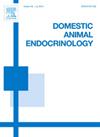甲肾上腺素受体拮抗剂对马静脉葡萄糖负荷后碳水化合物代谢的影响
IF 2.1
2区 农林科学
Q2 AGRICULTURE, DAIRY & ANIMAL SCIENCE
引用次数: 0
摘要
Vatinoxan是一种外周作用的α 2-肾上腺素受体拮抗剂,用于兽药,以减轻α 2-肾上腺素受体激动剂的副作用。在其他物种中,Vatinoxan还能增加胰岛素反应并降低静脉注射葡萄糖后的血糖(BG)。本研究的目的是探讨瓦替诺散对马静脉注射葡萄糖后血糖和胰岛素浓度的影响。设计为评估盲交叉研究。9匹马静脉注射vatinoxan (0.2 mg/kg;VAT)或生理盐水(SAL)。每次治疗前立即给马静脉注射葡萄糖丸(150 mg/kg)。采集血液样本至300分钟。通过重复测量协方差分析评估治疗间的差异。从基线的变化被用作响应。p & lt;0.05被认为是显著的。静脉注射葡萄糖后,所有马的血糖和胰岛素均升高。与SAL相比,VAT显著降低了BG的增加(p = 0.005)。虽然胰岛素在VAT后15 min(中位数45.7,min-max 20.7-61.6µIU/mL)与SAL相比,最初显著增加(p = 0.04;28.3、17.2 ~ 44.5µIU/mL),总体治疗效果差异无统计学意义。胰岛素浓度峰值在VAT(中位Tmax 30, min-max 15-60 min)后明显早于SAL(中位Tmax 60, 15-60 min) (p = 0.04)。综上所述,vatinoxan比生理盐水更早地诱导胰岛素峰值,并降低静脉葡萄糖负荷后的BG升高。Vatinoxan可能潜在地改变高血糖期间胰腺的胰岛素分泌,但需要更多的研究。本文章由计算机程序翻译,如有差异,请以英文原文为准。
The effect of an alpha2-adrenoceptor antagonist on equine carbohydrate metabolism after intravenous glucose load
Vatinoxan is a peripherally acting alpha2-adrenoceptor antagonist used in veterinary medicine to attenuate the side effects of alpha2-adrenoceptor agonists. Vatinoxan also increases insulin response and reduces blood glucose (BG) after intravenous glucose in other species. The aim of this study was to investigate the effects of vatinoxan on BG and insulin concentration in horses after intravenous glucose. The design was an assessor-blind cross-over study. Nine horses were assigned to intravenous vatinoxan (0.2 mg/kg; VAT) or saline (SAL). Horses were administered an intravenous glucose bolus (150 mg/kg) immediately before each treatment. Blood samples were collected until 300 min. Differences between treatments were evaluated with repeated measures analysis of covariance. Change from baseline was used as a response. p < 0.05 was considered significant. After intravenous glucose, BG and insulin increased in all horses. VAT significantly reduced the increase in BG compared with SAL (p = 0.005). Although insulin increased initially significantly more after VAT at 15 min (median 45.7, min-max 20.7–61.6 µIU/mL) compared with SAL (p = 0.04; 28.3, 17.2–44.5 µIU/mL), there was no significant difference in the overall treatment effect. Peak insulin concentration occurred significantly earlier (p = 0.04) after VAT (median Tmax 30, min-max 15–60 min) than SAL (median Tmax 60, 15–60 min). In conclusion, vatinoxan induced an earlier insulin peak than saline and reduced BG increase after intravenous glucose load. Vatinoxan could potentially modify insulin secretion from the pancreas during hyperglycaemia, but more research is warranted.
求助全文
通过发布文献求助,成功后即可免费获取论文全文。
去求助
来源期刊

Domestic animal endocrinology
农林科学-奶制品与动物科学
CiteScore
5.50
自引率
4.80%
发文量
58
审稿时长
31 days
期刊介绍:
Domestic Animal Endocrinology publishes scientific papers dealing with the study of the endocrine physiology of domestic animal species. Those manuscripts utilizing other species as models for clinical or production problems associated with domestic animals are also welcome.
Topics covered include:
Classical and reproductive endocrinology-
Clinical and applied endocrinology-
Regulation of hormone secretion-
Hormone action-
Molecular biology-
Cytokines-
Growth factors
 求助内容:
求助内容: 应助结果提醒方式:
应助结果提醒方式:


